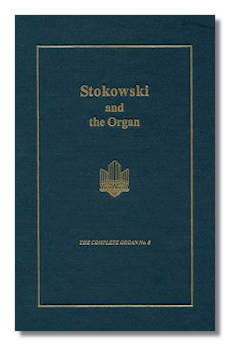
The Internet's Premier Classical Music Source
Related Links
-
Introduction
Acoustics
Ballet
Biographies
Chamber Music
Composers & Composition
Conducting
Criticism & Commentary
Discographies & CD Guides
Fiction
History
Humor
Illustrations & Photos
Instrumental
Lieder
Music Appreciation
Music Education
Music Industry
Music and the Mind
Opera
Orchestration
Reference Works
Scores
Thematic Indices
Theory & Analysis
Vocal Technique
Search Amazon
Recommended Links
Site News
 Book Review
Book Review
Stokowski and the Organ

Rollin Smith
Pendragon Press (2004) 270 Pages
ISBN: 1576471039
Okay, let's get this out of the way from the start. Anyone who loves the music of Leopold Stokowski simply MUST have this book. Whilst Oliver Daniel's book, Stokowski: A Counterpoint of View remains the definitive biography, Mr. Smith has given us an extensive look at Stokowski's early years as a musician. The book is so full of insights and anecdotes not available elsewhere, as well as photos I've not seen either, that it makes a fascinating read. Whilst there is a certain amount of technical jargon I won't pretend to fully understand I developed a sense of the complexity of being an organist, what it takes to play this "King of Instruments".
Mr. Smith provides several interesting details about Stokowski. "Stokowski was one of those rare individuals who only was interested in tomorrow… Once, when asked by an interviewer if he kept a scrapbook, he replied, 'Why? Why should I save scrap?'" Whilst it is not news that Stokowski was forever young, I love the anecdote.
Stokowski's non-musical education never went beyond grade school. I guess I didn't know that either. Obviously he didn't need it. In so many ways Stokowski was an autodidact. I have a photo of him in my study. Stokowski is sitting at his desk in his study; the walls are lined with books. I suspect that not all of them were musical scores and from his conversations he was an avid reader of all kinds of works.
There is not a whole lot new about his work at St. James; it is probably due to the fact that there was not nearly as much press as when Stokowski went to New York.
When we get to New York, however, things change dramatically. St. Bartholomew seated a thousand people and was the wealthiest church in NY City. It was referred to as the Vander-built Church because Cornelius contributed much of the construction costs. And yes, he was the grandfather of Gloria who Stokowski later married.
Stokowski's own recollections of the organ at St. Bartholomew's are interesting.
"I found a splendid organ. It was in three parts. On the south side, the north side and then at the extreme end, that is east of the church, was a third organ. And they could all be played from the one console. Well, I found that extremely interesting because it's something like what happens with the orchestra where, on the conductor's left are certain instruments, on his right, other instruments, and on the center at the back, still a third group of instruments." The italicized portion was omitted from Oliver Daniel's book. I talked with the executor of Oliver's estate, Don Ott, and he told me that 30% of the biography was cut by the publisher. There are several other comments in Smith's book that come from Oliver's "notes" and I assume these are other examples of the cutting floor clutter. As you can see, the restoration of the deletions adds a LOT to our understanding of Stokowski.
The reader will also discover that Stokowski's "creation of himself" was already taking place. In the first print information about Stokowski, The Musical Courier, 4 October 1905, it states, "He is well known in London as an orchestral conductor." We can easily deduce from whence this information came.
There are several fascinating comments by Blanche Yurka, who was an actress whose most famous role was as Madame Defarge in the 1935 MGM movie "A Tale of Two Cities". She is not cited at all in Oliver's book so the information is essentially new. As a teenager she was in Stokowski's choir at St. Bartholomew's. Among her recollections is this observation, "Bach as conducted by Stokowski was a revelation of dramatic intensity."
Several chapters are devoted to aspects of the organ throughout Stokowski's career.
The book discusses the Wanamaker Organ. Stokowski led the Philadelphia Orchestra twice in the department store where the Wanamaker organ was used. The department store had a huge lobby and for these special occasions they would clear it away to make place for the orchestra. The book also talks about the two times Stokowski played organ whilst on the 1936 Philadelphia tour of the USA. In addition there is a whole chapter on the Aeolian piano roll of Stokowski's transcription of Bach's Passacaglia (which was later orchestrated). Another entire chapter is devoted to the orchestral transcriptions from organ works. Each is given biographical information and performance details.
Having read this I now am certain that Stokowski's years as an organist deeply affected what was to become The Stokowski Sound. As the author put it, "Stokowski's orchestration and interpretation reflect organ performance practice at the turn of the century."
To recap and repeat, get this book!
Copyright © 2005 by Robert Stumpf II.


















